#Inheritance in Java
Explore tagged Tumblr posts
Text
Decode DSA with Python: Comprehensive Learning Including Python Tuple
Master Data Structures and Algorithms (DSA) with Python in this comprehensive guide. Learn key concepts step-by-step, including how Python tuples play a role in efficient coding. Whether you're preparing for coding interviews or improving your problem-solving skills, this tutorial offers practical insights and clear examples to boost your understanding of Python-based DSA. Click to read the complete guide
#bca course subjects#python tuple#Exception handling in Java#Collection framework in java#Inheritance in java#Interface in Java
0 notes
Text
Understanding Inheritance in Java: Exploring Types and Examples
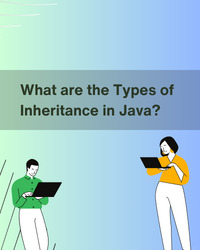
In the world of Java programming, inheritance is a powerful concept that allows developers to create a relationship between classes, fostering code reuse and organization. In this blog, we'll delve into what inheritance is in Java, explore its types, and provide practical examples to make it all crystal clear.
What is Inheritance in Java?
Inheritance is a key pillar of Object-Oriented Programming (OOP), enabling a class to inherit properties and behaviors from another class. The class granting the inheritance is known as the superclass or parent class, and the class receiving the inheritance is the subclass or child class. This mechanism promotes the reuse of code and establishes a hierarchy among classes.
Types of Inheritance in Java:
1. Single Inheritance:
In single inheritance, a subclass inherits from only one superclass. Let's illustrate this with a simple example:
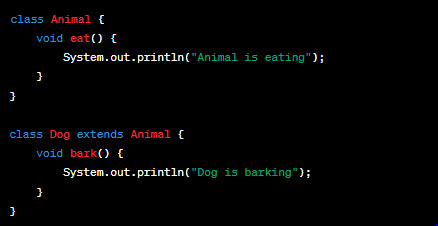
Here, Dog is the subclass inheriting from the Animal superclass. The Dog class can access the eat() method from the Animal class.
2. Multiple Inheritance (Through Interfaces):
Java doesn't support multiple inheritance for classes, but it does support it through interfaces. Consider the following:
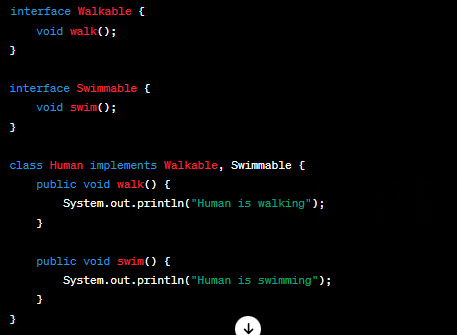
Here, the Human class implements both the Walkable and Swimmable interfaces, achieving a form of multiple inheritance.
3. Multilevel Inheritance:
In multilevel inheritance, a class inherits from another class, and then another class inherits from the second class, forming a chain. Let's see an example:
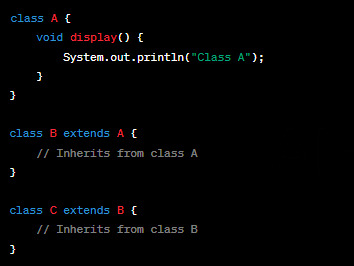
In this scenario, C inherits from B, and B inherits from A.
4. Hierarchical Inheritance:
In hierarchical inheritance, multiple classes inherit from a single superclass, creating a hierarchy. Consider the following:
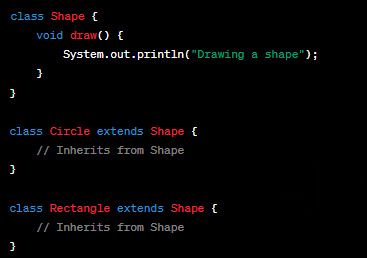
Here, both Circle and Rectangle inherit from the Shape superclass.
Benefits of Inheritance:
Code Reusability: Inheritance allows you to reuse code from existing classes, minimizing redundancy.
Method Overriding: Subclasses can provide specific implementations for methods inherited from the superclass.
Polymorphism: Objects of the subclass can be treated as objects of the superclass, enhancing flexibility.
Modularity: Inheritance aids in creating modular and easily understandable code by organizing classes into a hierarchical structure.
Conclusion
In conclusion, understanding inheritance in Java is fundamental to writing efficient and organized code. Whether you're a beginner or an experienced developer, incorporating inheritance into your Java programming skills can significantly enhance your ability to create robust and maintainable applications.
Get to Know more: https://analyticsjobs.in/question/can-you-please-tell-me-what-are-the-various-types-of-inheritance-in-java/
#java#inheritance in java#learn java#analyticsjobs#what is inheritance#types of inheritance#elearning#coding#programming
0 notes
Text
I have become yet another victim of the allure of inheritance
4 notes
·
View notes
Text
Java Inheritance Explained: 10 Programs to Deepen Your Understanding
Java inheritance, with its various forms and applications, is essential for building well-structured and maintainable code. By experimenting with these 10 inheritance types and scenarios, you can gain practical insights into designing versatile Java applications. Understanding the different inheritance in Java types will help you create more efficient code structures, promoting reusability, scalability, and easier maintenance. Embrace inheritance wisely, and it will serve as a solid foundation in your journey to mastering Java and object-oriented programming principles. Read more: https://myworldgo.com/blog/135972/java-inheritance-explained-10-programs-to-deepen-your-understanding
0 notes
Text
Why do I feel like bunnies inherit from the abstract class "mob" and therefore have to implement these things?
Doing some Minecraft modding and thrilled to discover that bunny rabbits have an attribute called EVIL ATTACK POWER.

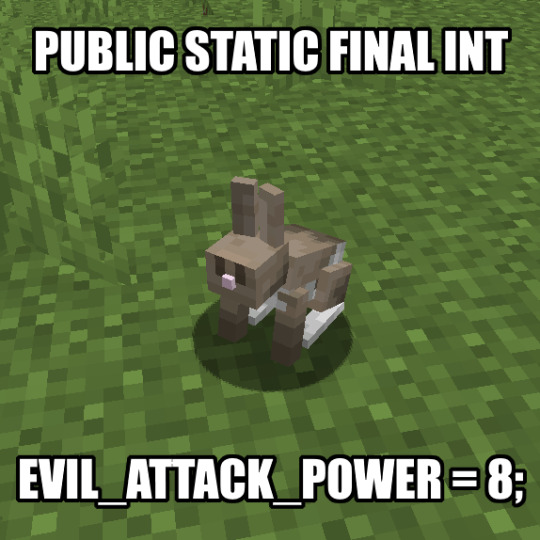
#my java is kinda weak#I've been doing either android or c++ lately so I'm not working with inheritance structures in java rn
12K notes
·
View notes
Text
What's Yours is Mine! Inheritance in Java
In Java, a class can inherit all of the method logic from parent(s) implementations without any additional work besides extending that parent. Let's look at a partial class diagram for java.util.ArrayList to see how this works.
💚 TIP: References Quick List Java: Inheritance Java 17 Javadocs: AbstractCollection AbstractList ArrayList Collection Iterable List Object Mermaid Diagrams – Class Diagram Syntax UML Diagram Basics Example Code Table of Contents Table of ContentsIntroductionAbstract / Interface MethodsgetInherited Methods with Bodies (Concrete)toStringJava SyntaxSummaryThe Diagram Introduction One of the…
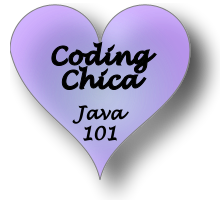
View On WordPress
0 notes
Note
(prev. Anon here). While I cannot say i completely understand your experience (my dads mixed Asian (Indonesian, Java island and another island but my dad doesn't remember which and the family doesn't really talk about th Indonesian heritage) and I inherited curly hair, also the nose and the eyes, I love looking like my grandpa), hair is a lot more then just hair.
Before I got ill I had more like 3c and some strands 4a (now I know how to take care of it so it's getting back to that!!), an old friend literally thought I was a homeless person. And when i got mad my teacher said; 'hair is just hair dont get worked up'
Anyways, I'm basically saying comments about hair just being hair just suck.
(I'm not English so sorry for me rambling, English isn't a very direct language to me so I find it difficult to be direct in English, I'm working on it, I promise!!!)
I know, right? Your English is just fine, pookie! I hate that people with curls and curlier hair have to just deal with those statements because it's not just hair. Like I said, it's culture and community. I literally had one teacher call me exotic for my curls, and I had people say, "It's just curls; you can wash it." When wash day is a war for me, even if you're not Black, I feel like anyone with hair just like mine can relate, no matter what.
#x black reader#batfamily x neglected reader#yandere batboys#weird!reader#yandere batfam#yandere batfamily#black!reader#x neglected reader#black male reader#black fem reader#black nonbinary
40 notes
·
View notes
Text
o hi i use both of them! in particular rust is my favorite programming language
rust: fast like C/C++ but memory management doesnt suck unlike C/C++
If any Haskell and or Rust fans follow me, give me 1 good reason to learn them
#ultimately it depends on what you find convincing#rust is less popular than languages like C C++ and java so if you want a job then eh#if you don't need the performance of C then sticking to higher-level OOP languages like java is fine#notably rust lacks proper inheritance (though it does have other OOP features like polymorphism & encapsulation)#so if u use inheritance a lot then thats a reason to Not use rust#rust has a couple more specific language features that i really love so lmk if u want me to expand on them#as for haskell if ur not interested in functional programming then it's probably not worth it ngl#im a massive fuckin nerd so i like it but it definitely took a LOT of effort compared to any procedural language!
33 notes
·
View notes
Text
Master Polymorphism in Java – Scientech Easy
Dive into Polymorphism in Java with easy-to-follow guides at Scientech Easy. Learn how Java supports method overloading and overriding, enabling flexible and dynamic behavior in your programs. Perfect for enhancing your OOP skills!

#constructor in java#collection framework in java#Exception handling in Java#inheritance in java#Interface in Java#Python tuple#bca course subjects
0 notes
Text
A thing that still blows my mind is that C++ is an object oriented language.
And most do not know what that means! :D
So we have the abstraction paradime. Badically having private and public stuff. Public interfaces and private implementation with the interface being some sort of abstraction. I mainly mentions this because that is SEPERATE from object oriented.
And then we have object oriented. Basically inheritance.
As in, software can inheret other software and extend it.
So in C++ class DERIVED can inherentclass BASE. And that means class DERIVED can be used both as class DERIVED and class BASE
Many languages facilitates the use of object oriented design like this.
But some languages are also object oriented.
As in, C++ is build so it inherits C
So you can use C++ as either C or C++
And Python inherets C++
Yes. You can write a program only in C in Python
Kotlin inherets Java.
Many languages do this. Because different languages does different things. If the different things can be described as different abstraction layers then it might be smart to let the higher abstraction level ones inheret from the lower abstraction level ones
Well written Python contains C for the very low level stuff, C++ for efficient safe use of HAL layer above it, and python for the system stuff
But if your python program have only higher lever stuff, it only needs to contain Python!
It is so flexible and neat! :D
#codeblr#programming#coding#softeware#software developer#software#the world is silly#software development#oop
8 notes
·
View notes
Text
At college I only learned C, java and fucking assembly (who the fuck uses assembly???). Also a little bit of phyton but it was more "look up how to make this thing happen, copy and paste in the code" instead of actually learning how it works.
Right now I'm trying to understand the rpg maker mv engine, that uses javascript. I've only learned object oriented programming using java.
Imagine my head trying to work around not needing to define the classes, methods and attributes of everything before creating an object.
The fuck you mean I can just add a new attribute out of nowhere to the object? Where are the fucking classes?
Well, after hitting my head against the wall for awhile I'm finally getting the idea of how things works here. Using prototypes to inherit stuff was really confusing at first.
9 notes
·
View notes
Text
Java Inheritance Explained: 10 Programs to Deepen Your Understanding
0 notes
Text
The concept of object oriented programming explained
Object-oriented programming is a fundamental concept present in numerous programming languages such as C++, Java, JavaScript, and more. It becomes straightforward once you truly grasp it, and that's precisely what this post aims to help you achieve. So, stop your scrolling for a second and delve into this post for a thorough and clear explanation.

Understanding the Term "Object-Oriented"
To grasp OOP, let's begin by explaining the name itself: "Object-Oriented." This term signifies that OOP revolves around entities known as "objects."
What Exactly Is an Object?
An object in OOP is any entity that possesses both state and behavior. Consider a dog as an example: it has states such as color, name, and breed, while its behaviors encompass actions like wagging the tail, barking, and eating.
The reason we introduce the concept of objects in programming is to effectively represent real-world entities, a task that cannot be accomplished with conventional variables or arrays.
Classes: Abstract Forms of Objects
Now, what about classes? A class is essentially the abstract form of an object. If we take the example of a "dog," the object "Mydog" is a concrete instance, while the class "dog" represents dogs in a more general sense. Think of a class as a blueprint or template from which you can create individual objects.
Four Pillars of Object-Oriented Programming
Now that we've established the fundamentals of objects and classes. OOP is built upon four key principles:
Inheritance: Inheritance occurs when one object inherits all the properties and behaviors of a parent object. It promotes code reusability and facilitates runtime polymorphism.
Polymorphism: Polymorphism entails performing a single task in multiple ways. For instance, it can involve presenting information differently to customers or implementing different shapes like triangles or rectangles.
Abstraction: Abstraction is about concealing internal details while exposing functionality. Consider a phone call; we don't need to understand the intricate inner workings.
Encapsulation: Encapsulation involves bundling code and data into a single unit. Just like a capsule contains various medicines . In a fully encapsulated class (e.g., a Java bean), all data members are private, ensuring data integrity and controlled access.
I remember finding these images that explained these concepts using the 'Squid Game' series, and they are just perfect. So, I'm sharing them here and giving all credit to their owner :
Polymorphism , Inheritance , Encapsulation
#code#codeblr#css#html#python#studyblr#progblr#programming#comp sci#web design#web developers#web development#website design#webdev#website#tech#html css#learn to code#OOP#object oriented programming
44 notes
·
View notes
Text

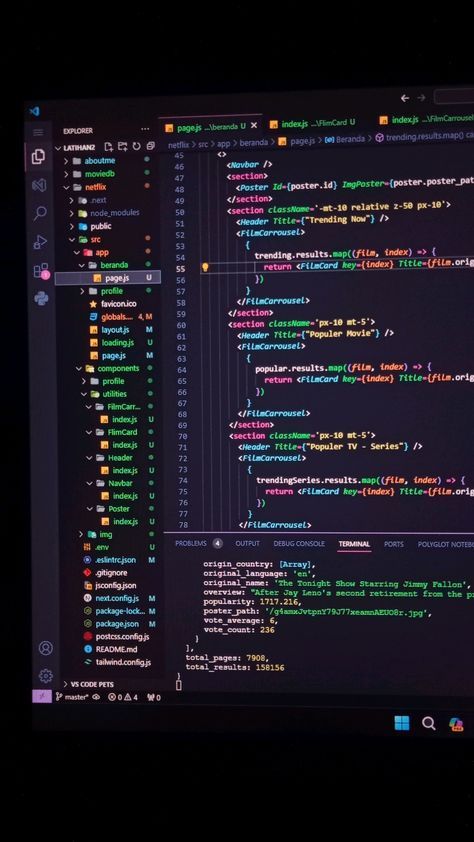
Took my CS final !! It was a class in Java. Everything I learned from my review:
Bro Code helped me SOO much omg - he was the best and I'll definitely check out his full java course on yt over my break
Working on a pdf of notes for you beginner Java learners on what helped me understand Inheritance, Polymorphism, Excepts and Recursion!
Not sure how I did yet, but I honestly probably got a 70... The multiple choice questions were worth 60 (we got those scores right away) so i got a 41/60 - i def didn't get all 40 points on the open ended so most likely a 70. I’ll end up with a B+ at least so not horrible.
Update (this was in my drafts): I got a 70 and did in fact get a B+ :) I’m okay with that.
#cs#curious#curiousity#productivityboost#stem academia#stem major#stem studyblr#stemeducation#study blog#studyblr#java#coding#learntocode#computer science
3 notes
·
View notes
Text
Good Code is Boring
Daily Blogs 358 - Oct 28th, 12.024
Something I started to notice and think about, is how much most good code is kinda boring.
Clever Code
Go (or "Golang" for SEO friendliness) is my third or fourth programming language that I learned, and it is somewhat a new paradigm for me.
My first language was Java, famous for its Object-Oriented Programming (OOP) paradigms and features. I learned it for game development, which is somewhat okay with Java, and to be honest, I hardly remember how it was. However, I learned from others how much OOP can get out of control and be a nightmare with inheritance inside inheritance inside inheritance.
And then I learned JavaScript after some years... fucking god. But being honest, in the start JS was a blast, and I still think it is a good language... for the browser. If you start to go outside from the standard vanilla JavaScript, things start to be clever. In an engineering view, the ecosystem is really powerful, things such as JSX and all the frameworks that use it, the compilers for Vue and Svelte, and the whole bundling, and splitting, and transpiling of Rollup, ESBuild, Vite and using TypeScript, to compile a language to another, that will have a build process, all of this, for an interpreted language... it is a marvel of engineering, but it is just too much.
Finally, I learned Rust... which I kinda like it. I didn't really make a big project with it, just a small CLI for manipulating markdown, which was nice and when I found a good solution for converting Markdown AST to NPF it was a big hit of dopamine because it was really elegant. However, nowadays, I do feel like it is having the same problems of JavaScript. Macros are a good feature, but end up being the go-to solution when you simply can't make the code "look pretty"; or having to use a library to anything a little more complex; or having to deal with lifetimes. And if you want to do anything a little more complex "the Rust way", you will easily do head to head with a wall of skill-issues. I still love it and its complexity, and for things like compiler and transpilers it feels like a good shot.
Going Go
This year I started to learn Go (or "Golang" for SEO friendliness), and it has being kinda awesome.
Go is kinda like Python in its learning curve, and it is somewhat like C but without all the needing of handling memory and needing to create complex data structured from scratch. And I have never really loved it, but never really hated it, since it is mostly just boring and simple.
There are no macros or magic syntax. No pattern matching on types, since you can just use a switch statement. You don't have to worry a lot about packages, since the standard library will cover you up to 80% of features. If you need a package, you don't need to worry about a centralized registry to upload and the security vulnerability of a single failure point, all packages are just Git repositories that you import and that's it. And no file management, since it just uses the file system for packages and imports.
And it feels like Go pretty much made all the obvious decisions that make sense, and you mostly never question or care about them, because they don't annoy you. The syntax doesn't get into your way. And in the end you just end up comparing to other languages' features, saying to yourself "man... we could save some lines here" knowing damn well it's not worth it. It's boring.
You write code, make your feature be completed in some hours, and compile it with go build. And run the binary, and it's fast.
Going Simple
And writing Go kinda opened a new passion in programming for me.
Coming from JavaScript and Rust really made me be costumed with complexity, and going now to Go really is making me value simplicity and having the less moving parts are possible.
I am becoming more aware from installing dependencies, checking to see their dependencies, to be sure that I'm not putting 100 projects under my own. And when I need something more complex but specific, just copy-and-paste it and put the proper license and notice of it, no need to install a whole project. All other necessities I just write my own version, since most of the time it can be simpler, a learning opportunity, and a better solution for your specific problem. With Go I just need go build to build my project, and when I need JavaScript, I just fucking write it and that's it, no TypeScript (JSDoc covers 99% of the use cases for TS), just write JS for the browser, check if what you're using is supported by modern browsers, and serve them as-is.
Doing this is really opening some opportunities to learn how to implement solutions, instead of just using libraries or cumbersome language features to implement it, since I mostly read from source-code of said libraries and implement the concept myself. Not only this, but this is really making me appreciate more standards and tooling, both from languages and from ecosystem (such as web standards), since I can just follow them and have things work easily with the outside world.
The evolution
And I kinda already feel like this is making me a better developer overhaul. I knew that with an interesting experiment I made.
One of my first actual projects was, of course, a to-do app. I wrote it in Vue using Nuxt, and it was great not-gonna-lie, Nuxt and Vue are awesome frameworks and still one of my favorites, but damn well it was overkill for a to-do app. Looking back... more than 30k lines of code for this app is just too much.
And that's what I thought around the start of this year, which is why I made an experiment, creating a to-do app in just one HTML file, using AlpineJS and PicoCSS.
The file ended up having just 350 files.
Today's artists & creative things Music: Torna a casa - by Måneskin
© 2024 Gustavo "Guz" L. de Mello. Licensed under CC BY-SA 4.0
4 notes
·
View notes
Text
Software Technical Interview Review List
Data Structures
Arrays (and Java List vs ArrayList)
String
Stack
Queue
LinkedList
Algorithms
Sorting (Bubblesort, Mergesort, Quicksort)
Recursion & Backtracking
Linear and Binary Search
String/Array algos
Tree traversal
Dynamic Programming
Graph algos (DFS, BFS, Dijksta's and Kruskals)
OOP fundamentals
Polymorphism
Inheritance
Encapsulation
Data abstraction
SOLID and GRASP
Explanations & example questions:
Strings and Arrays [ 1 | 2 | 3 | 4 | 5 | 6 | 7 | 8 ]
Stacks and Queues [ 1 | 2 ]
LinkedList [ 1 | 2 ]
Sorting & searching [ 1 | 2 | 3 | 4 | 5 | 6 | 7 ]
Recursion and Backtracking [ 1 | 2 | 3 | 4 ]
Dynamic Programming [ 1 | 2 | 3 | 4]
Graphs [ 1 | 2 | 3 ]
Tree [ 1 | 2 ]
General DS&A info and questions [ 1 | 2 | 3 | 4 | 5 ]
OOP review & questions [ 1 | 2 | 3 ]
#ive been procrastinating this coding assessment for my interview so bad 😭😭#im just scared of messing up cause i need this internship#But its due soon so im really buckling down now >:)#object oriented programming#algorithms#data structures#software engineering#ref#resource#mypost
20 notes
·
View notes